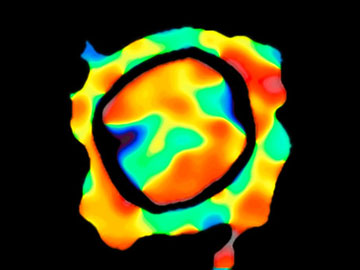Imaging a Star’s Roiling Surface
By combining the light of multiple ground-based telescopes to interferometrically create a long-baseline “virtual” telescope, researchers from Chile and Germany have been able to image the surface of Antares, a red supergiant star nearly 620 light years from Earth—and to measure the motion of its atmosphere (Nature, doi:10.1038/nature23445). Analysis of the researchers’ 2-D velocity field map of the star—which, according to the team, is the first such map of any star other than the sun—could ultimately help provide more information about the dynamics of stellar atmospheres and events, including those in stars that will eventually become supernovae.

A velocity field map over the stellar disk and extended atmosphere of Antares, a red supergiant star in the Scorpius constellation. [Image: European Southern Observatory / K. Ohnaka]
Near-IR spectro-interferometric imaging
To build their 2-D velocity map of Antares’ atmosphere, the researchers used instruments at the European Southern Observatory’s Very Large Telescope Interferometer (VLTI) in Cerro Paranal, Chile. The team combined light from three of the VLTI’s 1.8-meter diameter movable auxiliary telescopes in four different configurations, with baselines ranging from 4.6 m to 82 m, creating virtual scopes of various mirror diameters. They also applied VLTI’s near-IR beam combiner, the Astronomical Multi-Beam combineR (AMBER), to record spectrally dispersed interferograms across carbon monoxide lines between 2.28 µm and 2.31 µm with a spectral resolution of 12,000.
The AMBER data were used to reconstruct images of the star at 311 wavelength channels across the observed wavelength range. From the resulting data cube, the researchers extracted the spatially resolved spectrum at each position over Antares’ surface and atmosphere.
To measure the gas velocity over the star’s surface and atmosphere, the researchers used the cross-correlation between spatially resolved and unresolved spectra. This resulted in a 2-D velocity field map of the relative speed of the atmospheric gas across the star, as well as the speed of atmospheric gas at defined points. These speeds ranged from –20 to +20 km per second. In the red regions of the map (shown in the image above), gas is moving away from the viewer; in the blue areas, gas is moving toward the viewer. The black ring around the stellar disk shows where velocity measurements were not possible.
New questions
Information about Antares’ atmosphere is particularly interesting to scientists, because this dying red supergiant will eventually experience a rapid loss of mass before it goes supernova. Understanding the process that drives this rapid loss of mass could provide more information about the dynamics of stellar atmospheres and events.
In particular, the data from Antares have led the researchers to conclude that its atmospheric activity is not a result of convection, but of an unknown process. While the turbulent movement of gases across Antares’ surface and through its extended atmosphere resemble convection, the team says that it observed gas densities six orders of magnitude higher than what could be explained using traditional convection models.
“Convection alone cannot explain the density and extension of the atmosphere,” says team lead Keiichi Ohnaka, Universidad Católica del Norte, Chile. “Some yet-to-be-identified process must be operating to extend the atmosphere and give rise to the turbulent motions, and also perhaps the mass loss.” The next challenge for Ohnaka and his co-authors Gerd Weigelt and Karl-Heinz Hofmann from the Max Planck Institut für Radioastronomie, Germany, will be to identify that driving mechanism.
(From:https://www.osa-opn.org/home/newsroom/2017/august/imaging_a_star_s_roiling_surface/)
